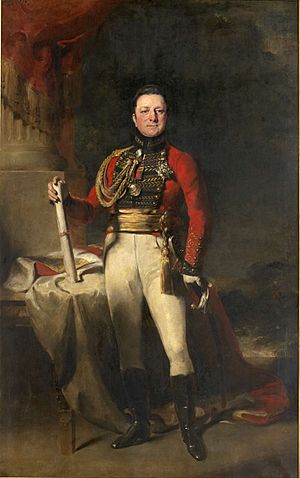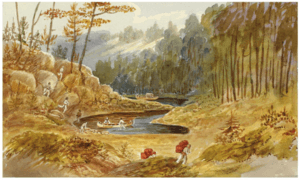George Ramsay, 9th Earl of Dalhousie facts for kids
Quick facts for kids
The Earl of Dalhousie
|
|
|---|---|
 |
|
| Governor of Nova Scotia | |
| In office 1816–1820 |
|
| Monarch | George III |
| Preceded by | George Stracey Smyth |
| Succeeded by | Sir James Kempt |
| Governor General of British North America | |
| In office 1820–1828 |
|
| Monarch | George IV |
| Preceded by | The Duke of Richmond |
| Succeeded by | Sir James Kempt |
| Commander-in-Chief of India | |
| In office 1830–1832 |
|
| Monarch | William IV |
| Preceded by | The Viscount Combermere |
| Succeeded by | Sir Edward Barnes |
| Personal details | |
| Born | 23 October 1770 Dalhousie Castle, Midlothian, Scotland |
| Died | 21 March 1838 (aged 67) Dalhousie Castle, Midlothian, Scotland |
| Nationality | British |
| Spouse | Christian Broun |
| Children | 3 sons, including James |
| Parents | George Ramsay, 8th Earl of Dalhousie Elizabeth Glen |
| Alma mater | University of Edinburgh |
George Ramsay, 9th Earl of Dalhousie (born October 23, 1770 – died March 21, 1838) was an important Scottish soldier and leader. He was known as Lord Ramsay until 1787. He served in many key roles for the British Empire. These roles included Governor of Nova Scotia, Governor General of British North America (which included parts of what is now Canada), and Commander-in-Chief in India. His son, James, also became a Governor-General of India later on.
Contents
Early Life and Education
George Ramsay was born at Dalhousie Castle in Midlothian, Scotland. His father was George Ramsay, 8th Earl of Dalhousie. His mother was Elizabeth Glen.
He attended the Royal High School in Edinburgh. Later, he studied at the University of Edinburgh.
Military Career Highlights
After his father passed away in 1787, George Dalhousie joined the British Army. He started as a cornet in the 3rd Dragoons in July 1788. He quickly moved up the ranks.
Serving in Different Campaigns
In 1791, he joined the 1st Foot regiment. By 1792, he was a major in the 2nd Foot regiment. He traveled with his regiment to Martinique and became a lieutenant-colonel in 1794. He was badly hurt in 1795 and returned to Britain.
He served in the Irish Rebellion of 1798 and later in the Flanders campaign in 1799. In 1800, he became a colonel. He fought in Egypt, capturing Rosetta and Fort Julien in 1801. By 1805, he was a Major-General.
Role in the Peninsular War
During the Peninsular War, Dalhousie led the 7th Division under the Duke of Wellington. He was thanked by Parliament for his service at the Battle of Vitoria. Here, he commanded the Left Center Column.
He was promoted to lieutenant-general in 1813. He also became a colonel of the 13th Foot regiment. He led his division in the Battle of the Pyrenees. Later, he helped occupy the city of Bordeaux.
A Soldier's Brave Act
There is a story about William Kemley, a soldier, who saved Ramsay's life in battle. Kemley held a flag over Ramsay's body to protect him. In doing so, Kemley was shot in the hand, leaving a permanent hole. For his bravery, William Kemley was given a house on the Dalhousie Estate, rent-free for life. His daughter, Caroline Kemley, was born under a gun carriage the night before the Battle of Quatre Bras.
Important Leadership Roles
In 1815, George Ramsay was given the title Baron Dalhousie. This allowed him to sit in the House of Lords, which is part of the British Parliament.
Governor of Nova Scotia
In 1816, Ramsay became the Lieutenant Governor of Nova Scotia. He took this position to help pay off debts from expanding his family estate. He hired an official artist, John Elliott Woolford, who created many drawings and paintings.
One of his most lasting achievements in Nova Scotia was creating Dalhousie College in Halifax. This college later grew into the well-known Dalhousie University.
Governor General of British North America

From 1820 to 1828, he served as the Governor General of British North America. This was a very important role, overseeing British colonies in what is now Canada.
Commander-in-Chief in India
In 1828, Dalhousie was appointed Commander-in-Chief of the Indian Army. This was a demanding role, and the army headquarters moved between Calcutta and Simla. The climate and work in India affected his health. He resigned from this position in 1832.
Retirement and Final Years
After returning from India, Dalhousie's health began to decline. He retired to his estate in 1834. His health continued to worsen until he passed away four years later in March 1838.
Family Life
Lord Dalhousie married Christian Broun in 1805. She was known as a "zealous botanist" and was very interested in plants.
George and Christian had three sons. Sadly, their two older sons died young. George Dalhousie passed away at Dalhousie Castle in March 1838, at the age of 67. His youngest son, James, inherited his title. Lady Dalhousie died in January 1839.
Legacy and Lasting Impact
George Ramsay left a significant mark in many places.
- He founded Dalhousie University in Halifax, Nova Scotia.
- The town of Dalhousie, New Brunswick was named after him when he visited in 1826.
- The villages of East and West Dalhousie in Nova Scotia are also named after him.
- Other places include Earltown and Port Dalhousie (part of St. Catharines, Ontario), a community in Calgary, Alberta, and Dalhousie Station and Dalhousie Square in Montreal.
See also
- List of universities named after people

